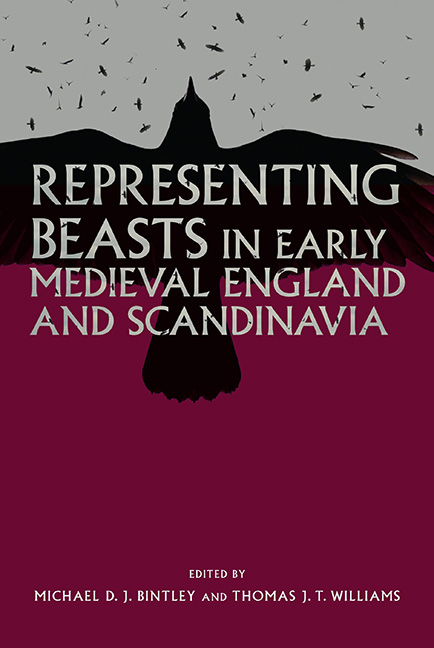Book contents
- Frontmatter
- Contents
- List of Figures and Tables
- Acknowledgements
- List of Contributors
- List of Abbreviations
- Introduction
- 1 Between Myth and Reality: Hunter and Prey in Early Anglo-Saxon Art
- 2 ‘(Swinger of) the Serpent of Wounds’: Swords and Snakes in the Viking Mind
- 3 Wreoþenhilt ond wyrmfah: Confronting Serpents in Beowulf and Beyond
- 4 The Ravens on the Lejre Throne: Avian Identifiers, Odin at Home, Farm Ravens
- 5 Beowulf’s Blithe-Hearted Raven
- 6 Do Anglo-Saxons Dream of Exotic Sheep?
- 7 You Sexy Beast: The Pig in a Villa in Vandalic North Africa, and Boar-Cults in Old Germanic Heathendom
- 8 ‘For the Sake of Bravado in the Wilderness’: Confronting the Bestial in Anglo-Saxon Warfare
- 9 Where the Wild Things Are in Old English Poetry
- 10 Entomological Etymologies: Creepy-Crawlies in English Place-Names
- 11 Beasts, Birds and Other Creatures in Pre-Conquest Charters and Place-Names in England
- Index
- Anglo-Saxon Studies
1 - Between Myth and Reality: Hunter and Prey in Early Anglo-Saxon Art
Published online by Cambridge University Press: 11 June 2021
- Frontmatter
- Contents
- List of Figures and Tables
- Acknowledgements
- List of Contributors
- List of Abbreviations
- Introduction
- 1 Between Myth and Reality: Hunter and Prey in Early Anglo-Saxon Art
- 2 ‘(Swinger of) the Serpent of Wounds’: Swords and Snakes in the Viking Mind
- 3 Wreoþenhilt ond wyrmfah: Confronting Serpents in Beowulf and Beyond
- 4 The Ravens on the Lejre Throne: Avian Identifiers, Odin at Home, Farm Ravens
- 5 Beowulf’s Blithe-Hearted Raven
- 6 Do Anglo-Saxons Dream of Exotic Sheep?
- 7 You Sexy Beast: The Pig in a Villa in Vandalic North Africa, and Boar-Cults in Old Germanic Heathendom
- 8 ‘For the Sake of Bravado in the Wilderness’: Confronting the Bestial in Anglo-Saxon Warfare
- 9 Where the Wild Things Are in Old English Poetry
- 10 Entomological Etymologies: Creepy-Crawlies in English Place-Names
- 11 Beasts, Birds and Other Creatures in Pre-Conquest Charters and Place-Names in England
- Index
- Anglo-Saxon Studies
Summary
‘… most swift and wise and divine’.
Arrian (Cynegetica, V.6) on his Celtic hunting dog named Horme (Impulse)Isidore of Seville (c. AD 560–636), in his Etymologiae siue Origines, interpreted the Latin word for animal as deriving from animans (living), ‘because they are animated (animare) by life and moved by spirit’. Isidore derived much of his information directly from the great imperial Roman author Pliny (d. AD 79), whose Books VIII–XI in his Naturalis Historia divided the animal world into creatures of land, sea and sky. The Romans not only observed and commented upon creatures of every sort but also depicted them with varying degrees of naturalism in the major and minor arts.
Anglo-Saxon animal art was of a very different nature. Surviving ‘art’ from the fifth to the seventh centuries consists primarily of ornamental metalwork, worn as personal jewellery or used to embellish arms and armour, horse harness and containers. With few exceptions, animals were not made as sculptures in the round but were cast in low relief in copper alloy; high-status ornaments displayed animals shaped with filigree wire on precious metal or fashioned in gold and garnet cloisonné cellwork. Many of these images were highly stylised and decorative. Accompanying representations in organic materials such as bone, wood, leather and textile are virtually lost to us.
The creatures that can be identified in Anglo-Saxon period metalwork are principally quadrupeds and birds, complemented by snakes and fish. The quadrupeds included canines, boars and probably horses; birds were generally raptors with curved beaks. In some cases these appear only as disembodied heads or as heads united with interlace to form ambiguous zoomorphs. There are, in addition, a few identifiable mythological composites derived from Classical forms, notably winged griffins, marine creatures with coiled tails, and hybrids derived from these. Both Pliny and Isidore included griffins in their compendia, Pliny judging them to be fabulous (Naturalis Historia X.lxx), but Isidore accepting their existence (Etymologiae XII.ii.17). Isidore (Etymologiae XII.vi.8) also simply accepted the existence of vast sea monsters, distinct from or related to whales. For the purposes of this paper, all these creatures – mammals, birds, reptiles and fantastic hybrids – are broadly referred to as animals.
- Type
- Chapter
- Information
- Publisher: Boydell & BrewerPrint publication year: 2015
- 3
- Cited by



